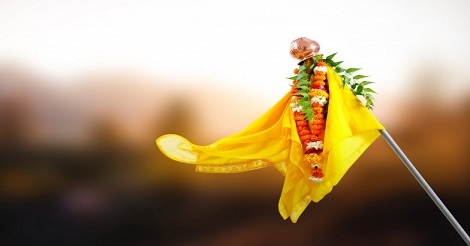Gudi Padwa 2020
Gudi Padwa, also known as Marathi New Year signifies the beginning of a new year for all Maharashtrians and Konkanis across Maharashtra and Goa. It usually falls on the first month of the Luni-solar calendar. This usually happens either in the last week of March or the first week of April. The Luni-Solar calendar is designed by keeping in mind the positions of the Sun and the Moon on different days, thus dividing the full calendar into months and days. The name Gudi Padwa is derived as follows: Gudi or Gudhi, as it is rightly pronounced, refers to a flag which is erected in front of all houses on this day and Padwa means the first day which is derived from the Sanskrit word Pratipada. In short, for all Maharashtrians and Konkanis, Gudi Padwa refers to the birth of a new year with new beginnings.
Gudi Padwa is celebrated differently amongst people all over the country.
* In Karnataka, Kannadigas or people who speak Kannada celebrate this festival as “Ugadi”
* In Andhra Pradesh, this festival is again known as “Ugadi” or “Telugu New Year”
* Sindhis across the country celebrate this by the name of Cheti Chand
There is a certain section of people who celebrate New Year on the basis of the Solar Calendar. This does not fall on the same day as Gudi Padwa, however, it is celebrated with same pomp and fervour. Hindu New Year which is celebrated according to the Solar calendar is known as:
* “Puthandu” in Tamil Nadu
* “Bihu” in Assam
* “Baisakhi” in Punjab
* "Poila Boisakh" which is also denoted as "Naba Barsha" in West Bengal
Usually, the above mentioned four festivities mostly fall around 13th, 14th or 15th of April every year.
In short, Hindus across India celebrate Hindu New Year on different days and denote it by different names.
What is Gudi or Gudhi all about?
Being born and brought up in Mumbai, I always used to wonder what the colourful stick, which stood out of most Maharashtrian homes on the day of Gudi Padwa, meant. Later on, I was told by my friends that they refer to it is a Gudhi. A Gudhi is created by tying a colourful, shiny silk cloth on a bamboo stick and decorating it with neem and mango leaves and flowers. Then a cup made of copper, silver or bronze, also known as “handi”, is inverted and secured tightly across it, thus capping the stick. Then the Gudi, also known as a flag, is made to stand outside the door on the right side or it can even be placed on the terrace. Some of the significances of erecting the Gudhi outside homes are as follows:
* When King Shalivahana from Paithan, a place in Maharashtra, emerged victorious from a battlefield, his people hoisted the Gudhi in happiness.
* According to history, Gudhi also denoted the victory of Lord Rama when he returned to Ayodhya after defeating Ravana. In short, this denotes the victory of good over evil.
How Gudi Padwa is celebrated:
People on this day have an oil bath early in the morning and clean their homes in preparation for the festival. The Gudhi is installed outside the houses and colourful rangolis are drawn outside the doorstep. Tasty dishes like poori-shrikhand or Puran-Poli, a Maharashtrian sweet dish is made across most Marathi households.
Gudi Padwa 2020:
In the year 2020, Gudi Padwa falls on the 25th of March. With this, let us all hope people who celebrate this festival with utmost devotion will surely get blessings from the Almighty!!!
-
Talk to Astrologer On Call
Starting from 12 per minute only
-
Get Detailed Manual Report
Starting from 250 only
-
Read Article
Read Astrology Articles
- Vedic Astrology,...
- Exp - 12 Years
- English, Hindi
- K.P. Astrology, V...
- Exp - 25 Years
- English, Hindi
- Vedic Astrology
- Exp - 25 Years
- English, Hindi



